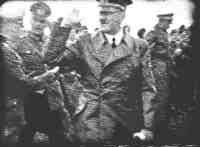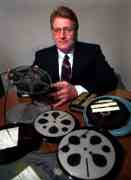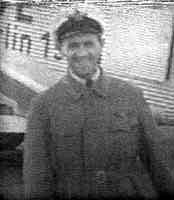 Thye Journal Sentinel, Milwaukee May
28, 2000
War
stories Rare
Hitler footage unearthed in Milwaukee
attic By Dave Daley
Special to the Journal
Sentinel World War II has been
analyzed, dissected, memorialized and,
thanks to novelists, film and cable TV,
virtually re-enacted countless times.
Certainly on this Memorial Day weekend,
many thoughts are turning to wartime, the
memory of Jews killed in the Holocaust,
and honoring American military
efforts. But as familiar as the outlines of the
war have become, there are still
surprising details awaiting discovery. Some of those details are locked in a
Cudahy bank vault: homemade movies of
Adolf Hitler and other top Nazis,
believed to have been taken by one of
Hitler's personal pilots and seized near
Hitler's Alpine stronghold by a Milwaukee
GI as World War II was ending.  I
watched about two hours of the grainy,
black-and-white films. They are a
fascinating peek into Hitler's inner
circle and the German high command from
1934, just after Hitler took power, to
mid-1940, when the German army overran
France. I
watched about two hours of the grainy,
black-and-white films. They are a
fascinating peek into Hitler's inner
circle and the German high command from
1934, just after Hitler took power, to
mid-1940, when the German army overran
France.
One sequence shows Hitler with a
magnifying glass, examining a document
just handed him as he gets out of a car.
The image-conscious Hitler rarely was seen
in official films in an unfavorable light
-- der Fuhrer had no weaknesses -- and the
segment is believed to be one of the few
showing Hitler's bad eyesight. The homemade films also reveal how hard
Hitler's image-makers worked to make him
look bigger than life. For example, Hitler
is shown making a presentation to a German
soldier, who is standing in a low spot
while Hitler looms over him, the official
photographer off to the side and behind
Hitler, shooting from an angle that shows
the towering Hitler and the soldier only
from the waist up. For more than
50 years, the 10 reels of films, which
add up to 2 hours and 39 minutes, sat
in a dusty attic, because the GI who
owned them vowed they'd never be made
public while he was alive. But after
his death in 1997, his family decided
to bring them to light. How valuable the films will turn out to
be is still unclear, but one authority
calls their footage of Hitler and his
generals in Poland at the start of World
War II "unique." "These are behind-the-scenes glimpses
that certainly add importantly to . . .
very familiar scenes of Hitler . . .,"
says Raye Farr, director of the
film and video collections at the U.S.
Holocaust Memorial Museum in Washington,
D.C., and an expert on World War II
newsreel-type films. 'War
Booty' While
the Milwaukee GI who obtained the films is
dead, his family still wishes to remain
anonymous, said Kevin Tschohl, a
Cudahy businessman who is representing
them. While
the Milwaukee GI who obtained the films is
dead, his family still wishes to remain
anonymous, said Kevin Tschohl, a
Cudahy businessman who is representing
them.
The GI was a paratrooper in the 101st
Airborne Division, the first U.S. unit
into the Berchtesgaden region in southern
Germany as Hitler's Third Reich was
collapsing in early May 1945. A
postcard-pretty resort area, the
Berchtesgaden was then the site of
Hitler's mountain retreat, dubbed the
"Eagle's Nest." The 101st Airborne guarded Hitler's
compound as well as an SS barracks and the
luxurious private homes nearby of top
Nazis like Martin Bormann and
Luftwaffe chief Hermann
Goering. Beneath Hitler's compound, the soldiers
found rooms stocked with fine crystal,
silver cutlery embossed with Hitler's
initials and Hitler's library and film
collections. As German soldiers
surrendered, their American captors were
handed all kinds of war souvenirs: Nazi
flags, Luger pistols, ceremonial SS
daggers. The Milwaukee GI apparently obtained
the films of Hitler from the Berchtesgaden
region at this time. "He must have
liberated this (the films) from one of
these little resorts," Tschohl says,
calling them "war booty." A longtime friend of the family,
Tschohl said he first saw the films 15
years ago when the ex-soldier showed them
in his home to family and close friends.
But the ex-soldier, a staff sergeant
awarded both the Purple Heart for war
wounds and two Bronze Stars, refused to do
anything more public with the films until
after he died. One reel shows Hitler touring the front
lines in September 1939 after Germany's
blitzkrieg attack on Poland, the invasion
that touched off World War II. Behind
Hitler is Erwin Rommel, at the time
in charge of Hitler's security, his fame
still ahead of him as the field marshal in
charge of the Afrika Korps. They also include footage of the
opening ceremonies of the 1936 Winter
Olympics, held in southern Germany in the
Austrian Alps, with Hitler on a viewing
platform surrounded by other top
Nazis. Another segment from a battlefield in
France in the spring of 1940, after the
German army decimated the French, shows an
SS intelligence officer inspecting a
captured French Charbis tank. The homemade nature of the films is
clearly evident in another sequence
showing top-ranking officers answering a
call of nature by the side of a plane at
the Polish front, then sticking out their
tongues as they turn around and find
they're caught by a photographer. Farr said some of the most important
film documentation of the Nazi period was
shot by Germans with home movie cameras.
"I'm sure a great deal has been lost, or
has never surfaced," she added. Farr, who viewed the films in January
in Milwaukee, said she was not aware of
any other film footage of Hitler at the
opening ceremonies of the 1936 Winter
Olympics. She says the U.S. Holocaust
Memorial Museum is interested in obtaining
the films -- or copies of them -- for its
collection. One reason the late GI's family is
considering a new home for the films is
the hope a museum or collector could
continue researching them, Tschohl
said. Behind the Camera
Discovering who shot the home movies
nearly became an obsession for Tschohl,
42, who runs Dad's Shop, a family tailor
business in Cudahy. First, Tschohl transferred the films --
65-year-old acetate and very fragile -- to
videotape that he watched over and over,
committing faces and places to memory. Tschohl quickly discovered the films
were a mixed lot: scenes of Hitler and
other top Nazis as well as personal films
of one individual, a man who appeared
throughout the 10 reels, both in a German
military uniform and in dapper, civilian
clothes. The mystery man also appeared to be a
playboy of sorts, shooting footage of half
a dozen different women outside resorts
and vacation spots. This man, Tschohl said
to himself, is the owner of the movie
camera that took all these films. Then Tschohl, a UWM dropout with no
experience in historical research, began
haunting local libraries. In books and
videos, Tschohl confirmed some of the
better-known faces in the films, including
such top Hitler lieutenants as Rudolph
Hess, Heinrich Himmler and
Joseph Goebbels. But the name of the mysterious
film-taker eluded Tschohl for close to 10
months. When he hit a dead end with
materials on top Nazis, Tschohl switched
to histories of the 101st Airborne. He
pored over hundreds of World War II books
and videos and contacted authorities on
the war at Marquette University and the
University of Wisconsin-Milwaukee. Finally, Tschohl was able to identify
an obscure face on the films as the Nazi
Third Reich's sports minister. A light
bulb went on: Tschohl remembered his
mystery filmmaker was shown in one segment
in a captain's uniform, stepping down from
an airplane that had "XI Olympiad 1936
Berlin," along with the Olympic rings,
painted on its side. Armed with that link, Tschohl said he
went back to the Milwaukee Public
Library's rarities section, the room where
he had started research many months
before, and discovered that a Capt. Gaim
was chosen in late 1935 to fly the German
Olympic Committee on a public relations
tour to European capitals. Tschohl believed he finally had his man
(right): Ludwig Gaim. A Fighter Ace
 Gaim,
an Austrian, was a World War I fighter ace
and a winner of the Austrian silver medal
of valor for aerial combat. Gaim also was
awarded the Iron Cross twice during World
War I. Gaim,
an Austrian, was a World War I fighter ace
and a winner of the Austrian silver medal
of valor for aerial combat. Gaim also was
awarded the Iron Cross twice during World
War I.
Born in 1892 in Deggendorf in
northeastern Bavaria, by 1920 Gaim was
married -- to a woman born in
Berchtesgaden -- and had a daughter. In the 1930s, Gaim worked for
Lufthansa, the German commercial airline,
and by 1937 was living in Berchtesgaden,
the same area where the Milwaukee GI found
the Hitler films. Gaim also was an early member of both
the Nazi party and the SS -- the
Schutzstaffel, or Hitler's personal guard
unit -- entering both in December 1931.
(By the end of the war he would earn both
the SS ring and the SS dagger, highly
prized by those around Hitler.) In 1937, when Hitler needed an
additional pilot, Gaim was recommended.
Hitler's chief pilot was Hans Baur,
who became a general; Hitler often flew
with two planes, Baur piloting one, Gaim
the other. Gaim's access to Hitler and his inner
circle is clear. Gaim is listed in one
book as one of the few people allowed to
eat in Dining Room #1, closest to Hitler's
dining room, at Hitler's wartime
headquarters in East Prussia, the "Wolf's
Lair." The films Gaim shot end in May-June
1940, probably because security around
Hitler tightened as the war spread
throughout Europe, Tschohl said. A year later, in December 1941, Gaim
was severely injured in an airplane crash
at Orel, Russia, suffering a crushed
kidney, two broken ribs, contusions and a
broken leg. At the time, Germany was
throwing every available German aircraft
into a massive effort to resupply the
German Sixth Army, surrounded at
Stalingrad by the Russians, which may
explain Gaim's presence in Orel then. His injuries made Gaim an invalid for
close to two years. In September 1943, in
a document to Heinrich Himmler,
head of the SS, Gaim was recommended for
promotion to full colonel, a rank he was
awarded in November. In January 1944, Gaim, his health
improved, asked for duty back at Hitler's
headquarters. The request noted that Gaim
was remarried -- to a woman 20 years
younger. Gaim, who had not been living
with his first wife for three years, asked
for the divorce, citing irreconcilable
differences. Gaim was given medical clearance for
security duty at Hitler's headquarters but
later that month, an SS general told Gaim
to retire. A month later, Gaim, by now age
52, was assigned to a reserve unit outside
Munich, made up mostly of older men.
Hitler's staff had said there really was
no need for Gaim's pilot skills because by
1944, Hitler was not flying. The records on Gaim end in 1944 in
Munich, with Gaim applying for a
disability card, and what happened to Gaim
by the war's end is not clear. Tschohl
said military records do not list Gaim as
killed in action. One intriguing
footnote: The reels in the Cudahy bank
vault may not be the only Gaim films
that have survived. In the fall of 1998, another American
veteran of World War II made public four
reels of amateur movies of Hitler. The
soldier, Herbert St. Goar of
Chattanooga, Tenn., said that he was given
the films around October 1945 in Munich by
a man who claimed he was one of Hitler's
pilots and claimed to have taken the
movies himself. St. Goar, in a U.S. Army intelligence
unit, said as he was questioning the man,
the German volunteered he had the films
and took St. Goar to his home in Munich
where the films were buried in his
backyard. Interviewed this February, St. Goar,
now 82, said that after all these years,
he does not remember the name the man gave
him. But this could have been Gaim. St. Goar's films, showing Hitler
touring occupied Paris, visiting war
wounded and meeting with Benito Mussolini
in Rome, are now stored at the federal
archives in Berlin in a room kept at minus
7 degrees Fahrenheit so the films will not
deteriorate, St. Goar said. The German magazine Der Spiegel
published photographs from the films in
October 1998 and last year German TV
broadcast a documentary, "The Third Reich
in Color," that included footage from his
films, St. Goar said. Beyond the Holocaust museum's interest,
Tschohl says he also has had contact with
private collectors about selling the
films. The family, Tschohl said, is
considering all options. Kevin Tschohl can be e-mailed at
[email protected]  Related index: Hitler
Related index: Hitler
|